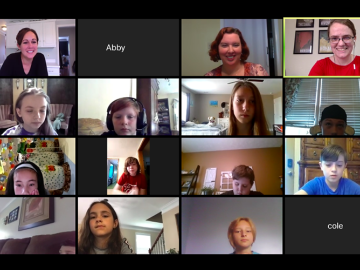
Filter News
Area of Research
- Advanced Manufacturing (3)
- Biological Systems (1)
- Biology and Environment (37)
- Computational Biology (2)
- Computational Engineering (2)
- Computer Science (5)
- Energy Science (92)
- Energy Sciences (1)
- Fusion and Fission (12)
- Fusion Energy (8)
- Isotopes (7)
- Materials (86)
- Materials for Computing (14)
- National Security (14)
- Neutron Science (121)
- Nuclear Science and Technology (18)
- Nuclear Systems Modeling, Simulation and Validation (1)
- Supercomputing (76)
News Type
News Topics
- (-) Advanced Reactors (37)
- (-) Big Data (70)
- (-) Biomedical (70)
- (-) Energy Storage (107)
- (-) Frontier (61)
- (-) Molten Salt (10)
- (-) Neutron Science (163)
- (-) Polymers (31)
- 3-D Printing/Advanced Manufacturing (137)
- Artificial Intelligence (127)
- Bioenergy (109)
- Biology (126)
- Biotechnology (38)
- Buildings (65)
- Chemical Sciences (83)
- Clean Water (32)
- Composites (33)
- Computer Science (216)
- Coronavirus (47)
- Critical Materials (28)
- Cybersecurity (34)
- Education (5)
- Element Discovery (1)
- Emergency (4)
- Environment (202)
- Exascale Computing (65)
- Fossil Energy (8)
- Fusion (63)
- Grid (70)
- High-Performance Computing (125)
- Hydropower (12)
- Irradiation (2)
- Isotopes (58)
- ITER (9)
- Machine Learning (64)
- Materials (147)
- Materials Science (145)
- Mathematics (11)
- Mercury (12)
- Microelectronics (4)
- Microscopy (51)
- Nanotechnology (58)
- National Security (81)
- Nuclear Energy (113)
- Partnerships (68)
- Physics (64)
- Quantum Computing (52)
- Quantum Science (89)
- Security (29)
- Simulation (61)
- Software (1)
- Space Exploration (26)
- Statistics (4)
- Summit (70)
- Transportation (92)
Media Contacts

Oak Ridge National Laboratory researchers have developed a thin film, highly conductive solid-state electrolyte made of a polymer and ceramic-based composite for lithium metal batteries.

Researchers at the Department of Energy’s Oak Ridge National Laboratory are refining their design of a 3D-printed nuclear reactor core, scaling up the additive manufacturing process necessary to build it, and developing methods

With Tennessee schools online for the rest of the school year, researchers at ORNL are making remote learning more engaging by “Zooming” into virtual classrooms to tell students about their science and their work at a national laboratory.

Researchers at Oak Ridge National Laboratory demonstrated a 20-kilowatt bi-directional wireless charging system on a UPS plug-in hybrid electric delivery truck, advancing the technology to a larger class of vehicles and enabling a new energy storage method for fleet owners and their facilities.

In the 1960s, Oak Ridge National Laboratory's four-year Molten Salt Reactor Experiment tested the viability of liquid fuel reactors for commercial power generation. Results from that historic experiment recently became the basis for the first-ever molten salt reactor benchmark.

Suman Debnath, a researcher at ORNL, has been elevated to the grade of senior member of the Institute of Electrical and Electronics Engineers (IEEE).

Researchers at the Department of Energy’s Oak Ridge National Laboratory (ORNL) in late February demonstrated a 20-kilowatt bi-directional wireless charging system installed on a UPS medium-duty, plug-in hybrid electric delivery truck.

In the race to identify solutions to the COVID-19 pandemic, researchers at the Department of Energy’s Oak Ridge National Laboratory are joining the fight by applying expertise in computational science, advanced manufacturing, data science and neutron science.

Oak Ridge National Laboratory researchers working on neutron imaging capabilities for nuclear materials have developed a process for seeing the inside of uranium particles – without cutting them open.



